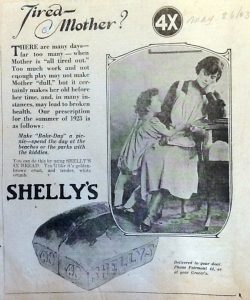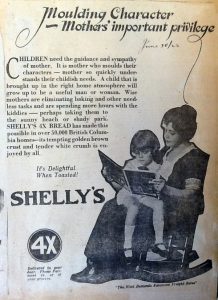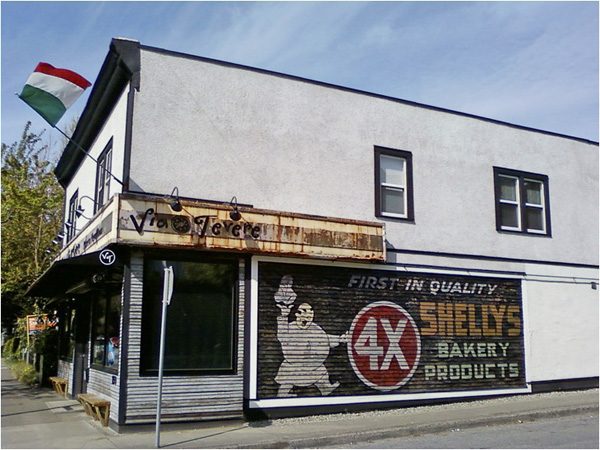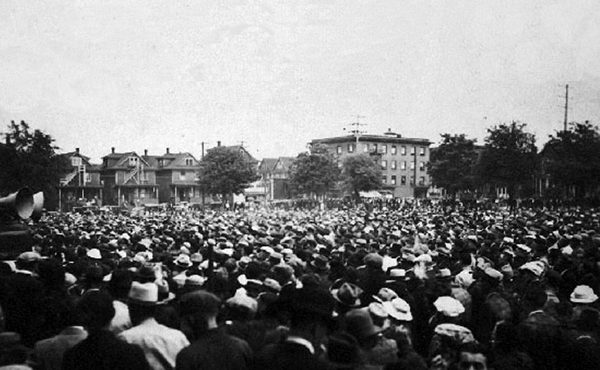
On a sunny day in East Vancouver in 2011, the new owners of a 1922 building were renovating the ground floor into what is today the Via Tevere Pizzeria, when they uncovered a unique portal to Vancouver’s past.
Peeling back a 50-year layer of stucco, they found a faded advertisement that had adorned the side of what was originally the Victoria Drive Grocery for three-quarters of a century. A happy, rotund baker tossing his hat in the air markets the long-gone Shelly’s 4X Bakery, which delivered bread door-to-door in the 1920s and promised to free housewives from the drudgery of baking.
The discovery of this “ghost ad”—unique in part because it was painted on wood rather than brick—piqued the interest of several heritage enthusiasts, including artist / author Michael Kluckner, who had recently moved back to Vancouver, after a 15-year hiatus.
Ads painted on the sides of buildings were once ubiquitous in Vancouver, but waves of demolition have left few examples behind. Those that survive offer glimpses into the commercial ventures of earlier generations and reveal the evolution of marketing strategies and social mores. “They speak to a kind of era with so much freedom that people could just paint a huge advertising sign without going to the city for a permit,” says Kluckner.
Kluckner and his colleagues in the Grandview Heritage Group led the charge to rehabilitate the sign with financial support from the pizzeria owners.
 Curious to determine the sign’s age and learn more about the bakery’s history, Kluckner tracked down a scrapbook in the city archives belonging to William Curtis Shelly – the shrewd businessman who made a fortune operating his namesake bakery. It contained his collection of newspaper ads for the Shelly’s 4X bakery brand that appeared in the women’s sections of The Vancouver Daily World and The Province.
Curious to determine the sign’s age and learn more about the bakery’s history, Kluckner tracked down a scrapbook in the city archives belonging to William Curtis Shelly – the shrewd businessman who made a fortune operating his namesake bakery. It contained his collection of newspaper ads for the Shelly’s 4X bakery brand that appeared in the women’s sections of The Vancouver Daily World and The Province.
Catering to the expanding middle-class audience of the post-WW1 period, the ads portrayed the social ideals and anxieties of the era.
“More than 15 hours’ drudgery in every sack of flour”
“This was in a period of time where quality of life is becoming important for the first time, and the drudgery of women’s existence is being noticed,” says Kluckner, “enough that it becomes an advertising selling point.”
An ongoing theme was the tired and overworked mother whose household chores made her “old before her time” and left her little time to rear productive children and keep her hubby happy. By buying Shelly’s bread, and freeing herself from the drudgery of baking, she had more time to “take the kiddies to the park” and to produce the “right home atmosphere” that would allow her child to become a useful adult.
 The ads appeared in a time when anti-Asian sentiment was widespread and maternal feminists portrayed women as “angels of the home” and “mothers of the race”. Influenced by eugenic ideas, social reformers of the time argued that white mothers had an important civilizing mission and were responsible for the survival of “White Canada”. Politicians like Mary Ellen Smith – the first woman elected to the BC legislature – promoted respectable child-rearing as the key to improving society and protecting the Anglo-Canadian race. Smith advocated for legislation that gave financial support to white mothers while excluding those from other ethnicities (Mothers’ Pensions Act) and that aimed to limit white women’s employment in Chinese-owned businesses, to protect them from the supposed health and moral risks they might suffer (Women’s and Girl’s Protection Act, 1923).
The ads appeared in a time when anti-Asian sentiment was widespread and maternal feminists portrayed women as “angels of the home” and “mothers of the race”. Influenced by eugenic ideas, social reformers of the time argued that white mothers had an important civilizing mission and were responsible for the survival of “White Canada”. Politicians like Mary Ellen Smith – the first woman elected to the BC legislature – promoted respectable child-rearing as the key to improving society and protecting the Anglo-Canadian race. Smith advocated for legislation that gave financial support to white mothers while excluding those from other ethnicities (Mothers’ Pensions Act) and that aimed to limit white women’s employment in Chinese-owned businesses, to protect them from the supposed health and moral risks they might suffer (Women’s and Girl’s Protection Act, 1923).
While Shelly’s ads don’t make explicit references to “all-white labour” – as did other ads of the time – Kluckner suggests that there are subtle allusions to mothers’ roles as keepers of a pure white race. One campaign drew on public health concerns and racial prejudices by emphasizing that Shelly’s bread was wrapped and only touched once by the gloved human hand, unlike the bread sold on the street by “itinerant peddlers”. And when anxieties over neighbourhood groceries being overtaken by Asian proprietors increased, campaigns insisted Shelly’s bread was sold in the kind of grocery stores where you could feel confident sending your child.
“They wanted to make money, they were going to push every button they could,” says Kluckner.
Make money they did; in the mid-1920s the Ontario-born Shelly became one of the richest men in the province after he sold his company for $1.1 million to Canadian Bakeries Ltd. (a conglomerate he helped assemble). He also developed the first Grouse Mountain Chalet and became president of several other companies including the Home Oil Company and the Canada Grain Export Company. His streak of good fortune ended with his foray into provincial politics. After a stint on the Vancouver parks board, he served as finance minister in the ill-fated Tolmie government of 1928-33 where he delivered the biggest deficit in BC’s history.
In the first Vancouver Historical Society talk of the season, VHS president Michael Kluckner will explore Shelly’s 4X Bakery ad campaigns and delve deeper into the businessman and politician’s legacy. His talk takes place this Thursday September 22 at 7:30pm at the Museum of Vancouver. Entrance is by donation and everyone is welcome to attend.
***
For more information on the upcoming Vancouver Historical Society lecture series, click here.
**
Michael Kluckner is the president of the Vancouver Historical Society and volunteers on the city’s Heritage Commission. The author and illustrator of more than 15 books, most notably the 1990 Vanishing Vancouver, he has recently turned his creative attention to graphic novels. Toshiko, a story set in BC during the Second World War involving a Japanese-Canadian girl, was published in 2015.
*
Madeleine de Trenqualye is a historical researcher and writer who has worked for Parks Canada, the National Historic Sites and Monuments Board and multiple heritage institutions. She has an M.A. in history from McGill University.





One comment
It’s comforting to see the author covered the whole story, adding to the story the entire spectrum – the debate on race prejudice, the plague that haunted our history and sadly still does far too much. I’m happy to see they didn’t touch upon just the nostalgic and exciting bits of uncovering a relic.